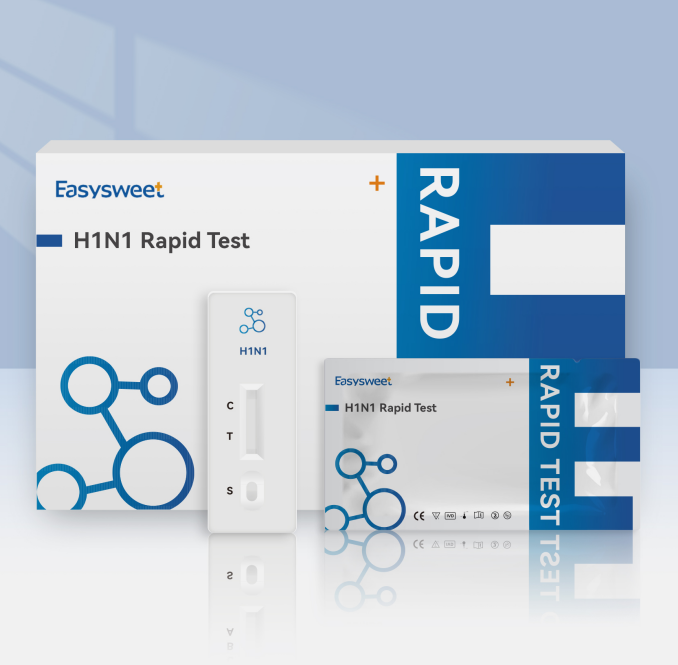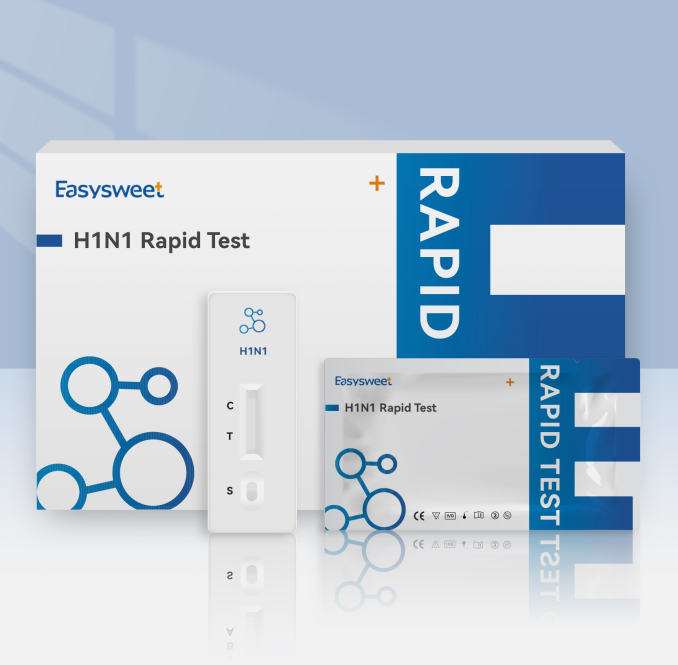H1N1 (swine flu) is caused by influenza A virus, a member of the Orthomyxoviridae family. H1N1 spreads from person to person through the air and sometimes from pigs to people. Influenza viruses have different pieces of RNA that can regenerate new strains and potentially cause outbreaks in unvaccinated people. Recombination is the process by which new strains emerge in pigs because it has specific receptors for both human and avian influenza viruses. H1N1 specifically binds to α-2,6 glycosidic linkages present in human airway cells and pigs. The Easysweet H1N1 Rapid Test takes 15 minuter, considering the fact that the virus multiplies rapidly in living cells. Currently, the method recommended by the World Health Organization to detect swine flu includes real-time PCR at a specific testing center, which takes 3-4 hours. Recently, many faster and more sensitive methods have also been developed, such as antigen-antibody or RT-LAMP and DNA biosensors.

Virus-borne infectious diseases are a major concern in today's world, with new virus outbreaks occurring every day and old ones becoming stronger and stronger. One such virus is the influenza virus, which comes in four types, A, B, C, and D. Importantly, influenza types A and B are responsible for major outbreaks compared to types C and D, which are less virulent, genetically stable and only infect animals. According to the antigenic composition, influenza A is further divided into different subtypes and several types according to the two main surface antigens hemagglutinin (HA) and neuraminidase (NA). There are 18 different types for HA and 11 different types for NA. Swine influenza is a fatal infectious respiratory disease caused by influenza A(H1N1) pdm09 virus of Orthomyxoviridae family. In April 2009, a novel influenza virus (H1N1) emerged in Mexico and spread around the world within a week, and the World Health Organization declared it a Phase 6 global pandemic on Ended on 10 August 2010 with several deaths worldwide (WHO report). It was first identified in pigs in the United States in 1930 as type porcine H1N1, following the 1918 H1N1 pandemic. The virus is the result of quadruple recombination with a triple hybrid virus of Eurasian (European and Asian) swine viruses, one of which is a descendant of the 1918 strain. It is a negative-sense single-stranded RNA virus with 8 segments encoding transcriptase, surface glycoprotein, hemagglutinin (HA), neuraminidase (NA), matrix protein, and nucleocapsid protein. It is a spherical virus with 80-120 nm filaments and a symmetrical helical nucleocapsid. HA and NA are responsible for the binding of virus to sialic acid in airway cells and the release of viral progeny from infected cells, respectively. HA of different viruses recognize different receptors on host cells, among which human influenza virus specifically recognizes the α, 2-6 glycosidic bond between sialic acid and galactose on respiratory cells, while avian influenza virus specifically recognizes α, 2- 3 glycosidic bonds. Pigs have two types of sialic acid receptors for antigens that either avian viruses or human susceptible viruses have. Therefore, they act as mixing vessels and provide sites for genetic recombination, resulting in antigenic shift.
Pigs have receptors for both avian and human influenza viruses (α-2,3 bond between sialic acid and galactose, α-2,6 bond between sialic acid and galactose).
Influenza virus vaccines are an effective tool, but must be constructed annually to cover all changes due to antigenic drift in RNA. Changes have been made recently to increase the effectiveness of the body's immune system and to speed up antibody production in case of seasonality and pandemics. Importantly, the development of a universal influenza virus vaccine is currently in the preclinical and clinical stages. There are many diagnostic methods such as enzyme-linked immunosorbent assay (ELISA), complement fixation test (CF), double immunodiffusion (DID), hemagglutinin inhibition (HI) and real-time polymerase chain reaction (RT-PCR), but some It takes 4–5 days to confirm, some are less specific. Therefore, the severity of the infection increases over time, hence the need for early detection of the infection. RT-PCR is a method of choice for confirming disease, but it is labor-intensive and costly. The assay showed 97% accuracy and a limit of detection (LOD) of 0.1–102 PFU/ml. The method is specific, accurate and highly sensitive to all influenza A strains, but it also takes time. Biosensors have a good ability to translate today's diagnostic methods into rapid analytical capabilities by reconfiguring their sensing behavior to detect any nanoscale objects such as antibodies, biomolecules and pathogens. Therefore, current sensing methods need to be continuously upgraded to address all the growing challenges in virus diagnostics. A good description to cover all the challenges, principles and types of biosensors and their applications in the diagnosis of different infectious diseases. Currently, nanotechnology-based sensors are used for rapid, sensitive, and cost-effective diagnosis of pathogens. Different nanomaterials have different applications and facilitate the interaction between these nanomaterials and viruses, which facilitates the development of portable biosensing tools for electroanalytical analysis for effective detection of influenza viruses.
A (H1N1) diagnostic method
Diagnosing the causative agent in the context of influenza is challenging because it exhibits symptoms similar to those of rhinoviruses, parainfluenza viruses, adenoviruses, and respiratory syncytial virus. Influenza viruses spread rapidly within 24 hours and can be collected within 2-5 days from nasal and tracheo-throat swabs that are introduced into transport media to preserve their viability until transport to specific laboratories and media samples for rapid detection of influenza. A large number of tests can be performed, depending on the type of detection factor, the specificity is also different, it can be antibody production, direct culture in cells, and nucleic acid amplification detection, such as RT-PCR and RT-LAMP, some detection of type A was reviewed earlier Methods for H1N1 influenza, such as virus culture, Easysweet H1N1 Rapid Test, direct immunofluorescence (DFA), and RT-PCR.
If there is any infringement, please contact us.


